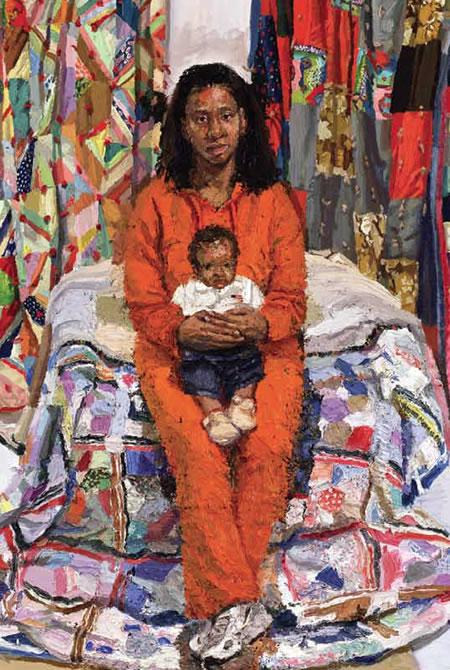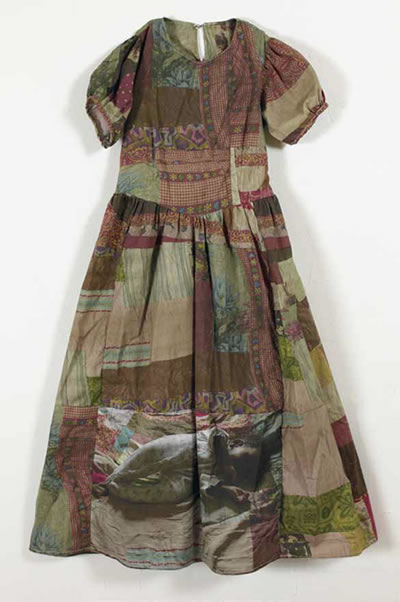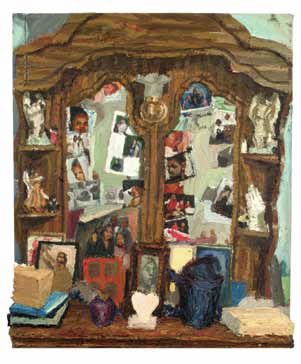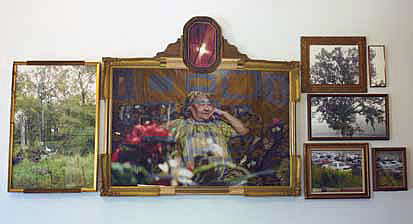Priorities & Persistence

Letitia and The Rising Sun, 2006, by Sedrick Huckaby.
All photos courtesy of the artists
Sedrick Huckaby's large-scale paintings draw inspiration from family history and African-American roots. A 2008 Guggenheim Fellow, his works are in the collections of the Whitney Museum of American Art, the Museum of Fine Arts Boston, the African American Museum in Dallas, and the Kansas African American Museum.
At his side is photographer Letitia Huckaby, whose multimedia works blend quilting and photography, threading together powerful pieces that pay homage to family. Her work has been shown extensively in the Dallas-Fort Worth area, and in New Orleans, Boston, Houston, and Harlem.
We sat down with this husband-and-wife team in their home and studios in Fort Worth, Texas, to discuss what it is like for two thriving artists in their 30s to balance career and family.
NEA: For both of you, your work explores themes of family and heritage. Can you talk about how this has evolved throughout your careers?
LETITIA: Shortly before I went to graduate school, my father passed, so I immediately started thinking about family and how I became the person that I am. He was from a small town in Mississippi called Greenwood, which is the fourth-largest producer of cotton in the country. I was a documentary photographer at that time, so I started taking pictures of cotton, cotton fields, and family members.
Through Sedrick's influence, I also started noticing my grandmother's quilts, not just as blankets passed down to me, but as fine art. So I started making quilts out of photographs of cotton and family members and began stitching them together, learning to sew as I went. My work now combines this documentary-style photography and my crafty side. I'm also becoming more sculptural with my work and have recently created dresses and freestanding forms incorporating images.
SEDRICK: My work has always been about African- American culture, family, and heritage. Some of the early works were paintings of different family members, sort of large-scale portraits that aggrandized ordinary people and things related to our family. At some point, I decided to single in on one figure, my grandmother, and I did a series of paintings of her and her house called Big Momma's House.
In tandem, I began painting still lifes, focusing on quilts. I always painted my grandmother's quilt, but it used to be in the background of the paintings, and then it transitioned and became the subject. I used it as a way to think about family legacy and commenting on the art that she made, like having a visual dialogue with her. And so, I started a series of large-scale paintings of quilts, culminating in an 80-foot-long work I call A Love Supreme.

Her Quilt, Our Flag, 2001, by Sedrick Huckaby. |
NEA: Working in such close proximity, how do you influence each other's work?
SEDRICK: Sometimes just looking at her work gives me ideas. Really, I think what she does is a lot more creative than what I do in that she uses a bigger variety of materials. Her work is more dynamic, because it's often three-dimensional. Even directly, she influences my work. For example, a piece at the University of Texas-Arlington, where I teach, is a painting of one of her quilts, with imagery, and one of my grandmother's quilts. It's about the generational dialogue.
LETITIA: And he makes me see things in different ways. For example, I might not have ever interpreted my grandmother's quilts as fine art or started exploring my own craftsmanship without his influence.
NEA: What would you say are the benefits and challenges of being married to another artist?
LETITIA: Sedrick understands what it takes to get the work done. He helps me watch the kids and picks up the slack when I have something big going on. Also, it's really nice to have someone to bounce ideas off of. You don't always take those ideas, but it's good to have someone to brainstorm with.
The downside is that sometimes it feels like we're two ships passing in the night, especially if we both are working on big projects.

Halle's Dress, 2009, by Letitia Huckaby, featuring a print of the Huckabys' daughter Halle Lujah. |
NEA: Do you ever feel competitive with each other? For example, is it difficult if one succeeds more than the other?
LETITIA: No, if one of us gets something big, then it's a win for both of us.
SEDRICK: That's right. We push each other to do the best we can do. If she's working toward something, I want to see her really accomplish it. If I know something big is coming up for her, I try to make my schedule flexible to help her out.
LETITIA: Yes, he makes a great studio assistant.
NEA: Have you worked on any pieces together?
SEDRICK: Not yet, but we are opening our first joint show at the Irving Arts Center in 2012 called Me, We. I'd like for us to do a piece together for that.
NEA: How do you manage the creative process while raising two children (Rising Sun, 5, and Halle Lujah, 2)?
LETITIA: Timing. Generally, I have a longer picture of the things I'd like to get done, and I weave them in and out of whatever's going on in our day-to-day lives. I take advantage of school or daycare time to get things done. We also have our studios at home, so being on-site makes it much easier to manage.
SEDRICK: I tend to work at night, because that's when everyone is sleeping and there are fewer distractions. This means that during the day I don't need to work as much and can spend more time with them, rather than painting.

The Altar Dresser, 2008, by Sedrick Huckaby. |
NEA: Do you feel like you have to sacrifice ambitions of becoming a "major artist" in order to raise a family, or can they go hand-in-hand?
SEDRICK: I've seen artists sacrifice family or feel like they need to make a choice between the two. I know you can have it all. Artists have a tendency to be a little selfish, because art can be all-consuming. But if you can be less selfish, then it's possible to have everything. In the end, I hope we can be an example that you can have a family with two successful, distinctive artists and it can all work together.
LETITIA: I think it's easy, though, to get sucked into that "art star" thing. There's a lot of pressure to keep reaching for a higher level, and sometimes I feel myself getting tempted by that and have to pull back. I have been blessed in that most of my success has come through people seeing the work and talking about it. So, I haven't had to take on this "try everything, do everything" lifestyle. I think there's more peace in your spirit when you just accept where you are and move with that.

East Feliciana Altarpiece, 2010, by Letitia Huckaby, a pigment print on silk. |
NEA: How do you involve your children in what you do professionally?
LETITIA: The children are curious about our art and they see us create it in our studios. We take them to our shows to see the end result of our work. In fact, prior to Sedrick's last show, we had one of his paintings hanging in our kitchen. When we took our son to the opening, he was very concerned that they had stolen that painting from our kitchen! They're making fun connections that way.
SEDRICK: Yes, and of course, anything they draw and do creatively is "all good." Masterpieces.
NEA: Do you have any advice for other young artists trying to manage it all?
SEDRICK: Balance. You know, I think there are two things that are important. One is to get your priorities straight. And then, stay persistent. Things may not come right away because a family sometimes means that it takes more time. But nothing is more important than just keeping with it, and eventually you will see good results.
The reality is that you can make the best plans, and then comes life. Everything can change on a dime, so you also need to learn how to be flexible. You don't know how or why or in what fashion, but if you stay with it, the world will open up to you on all levels.
-- Christy Crytzer Pierce is a writer and publicist in Fort Worth, Texas.








